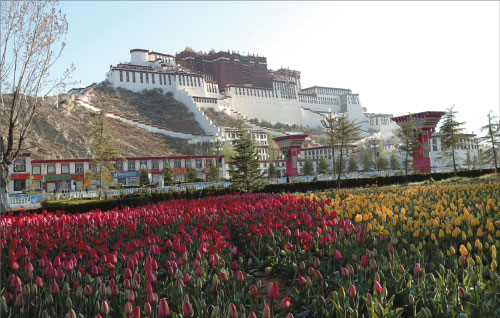 |
|
The southwest corner of the Potala Palace in Lhasa.[Photo/China Daily]
|
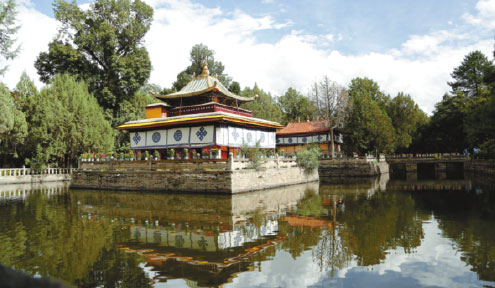 |
|
The water palace in Norbulingka Summer Palace in Lhasa. [Photo/China Daily]
|
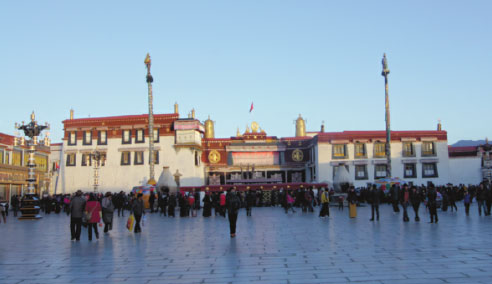 |
|
The Jokhang Temple in Lhasa. [Photo/China Daily]
|
The ancient Potala Palace has sustained its divine significance in modern times. Li Yang in Lhasa explores its spiritual prowess
The desolate vastness of the Tibetan Plateau seems another world to an urbanite like me. It's a place where life is hard-yet simple. My first trip to the Tibet autonomous region felt like a pilgrimage.
The Potala Palace is a must-see icon in the autonomous region's capital Lhasa because of its religious, cultural and historical significance.
It was the largest winter palace of Tibetan leaders in olden times and today serves as a symbol of the region. Its name means "holy place" in Vajravana Buddhism.
Potala's three nine-story buildings were constructed on the mountain in the seventh century to welcome the Tibetan king's fiancee, who hailed from the Tang Dynasty's (618-907) royal family.
But fires and wars destroyed the original buildings over the next millennium. The fifth Dalai Lama rebuilt the palace to its current 360,000-square-meter layout in the 17th century, and the central government renovated it in the 1930s and '90s.
It has survived the numerous wars and dozens of earthquakes over the past 700 years. The palace stands in its current form as a chronicle of the plateau's ups and downs over the centuries.
Potala is actually two main palaces-the larger White Palace at the base and the Red Palace above-plus a cluster of other structures higher up.
Both palaces comprise dozens of buildings constructed during different periods. The main building is 13 stories-117 meters-high and offers panoramic vistas of Lhasa.
The irregular baseline of the White Palace's granite walls seamlessly fuse into the mountain, which contrasts with the geometry of the hundreds of windows and wall tops crowned by dozens of golden roofs.
Within the Red Palace's red walls are the Dalai Lama's bedroom, living room, prayer room, guestroom and study room.
For both religious and practical reasons, visitors must observe several rules.
Hats, sunglasses and bottled water aren't allowed, and cameras can't be taken beyond the White Palace.
Potala only accepts 2,300 visitors a day from 9 am to 12 am, and 3:30 pm to 4:30 pm. Tickets must be booked a day in advance and cost 200 yuan ($33).
Tours of the inner palace start at a stone stairway leading to the compound's back entrance. They are limited to hourlong nonstop walks that pass by all the main sites, such as the scripture halls, and monks' dormitories and tombs.
Only a small section of the palace is open to the public.
The ancient architects paid special attention to the use of the natural light and ventilation through openings in the roofs and walls. All rainfall is collected for residents' daily use.
Virtually every surface is adorned with sculptures, frescos and tapestries. The dancing illumination emanating from butter lamps, the fragrance of incense and the chanting of sutras make the experience multisensory and, ultimately, spiritual.
Potala hosts more than 3,000 Buddhist statues, the largest of which is three stories high, while the smallest is fingernail sized.
Devotees tap wooden rails as a gesture symbolizing kowtowing to pray to each deity to seek its blessings according to its responsibilities in the divine division of labor.
The most pious travel to Potala from their hometowns by foot, kowtowing with each step along the way. They face Lhasa, stand straight, raise their hands, kneel and then lie on their stomachs and stretch out their arms, chanting sutras to the earth beneath their faces. Such ascetic practices demonstrate their faith while cleansing their souls.
Despite arduousness, the joy of moving closer to the holy place-physically and mentally-shows in their smiling faces.
The brand of happiness reflected in their eyes is scantly seen in the country's materially wealthier cities.
And even those of other faiths or none at all typically find a visit to Potala to be a spiritual experience.
Contact the writer at liyang@chinadaily.com.cn
RADIATING FROM THE CENTER
While Potala Palace is a globally recognized icon of Lhasa, there are several nearby sites worth visiting in the Tibet autonomous region's capital.
The Norbulingka Summer Palace, Jokhang Temple and Tibet Museum are three major attractions near Potala.
The Norbulingka Summer Palace was the Dalai Lama's historical residence since its construction in the mid-1700s. In the 1960s, the palace was converted into a park.
The parks' collection of rare plants and clusters of buildings make it a magnificent garden.
Jokhang Temple was built 1,300 years ago-the same time as the Potala Palace-and has since remained an important Tibetan religious center.
It's surrounded by kowtowing worshipers and shops selling local specialties.
And a visit to the nearby Tibet Museum provides context for tours of Lhasa's other sites.
We Recommend:

|
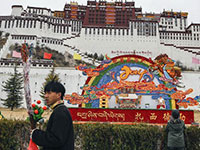
|
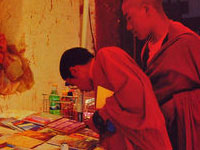
|
|
Music fountain and night scenes at the Potala Palace
|
'Shangri-la complex' stymies rational perception of Tibet
|
Tibetan culture on display in Strasbourg
|
